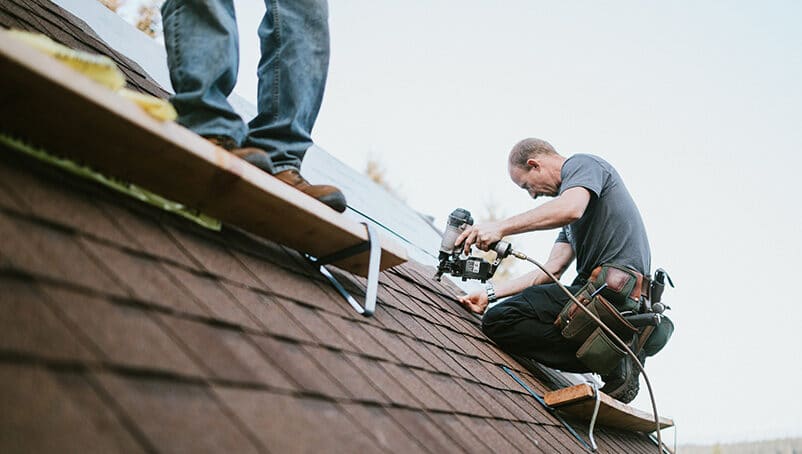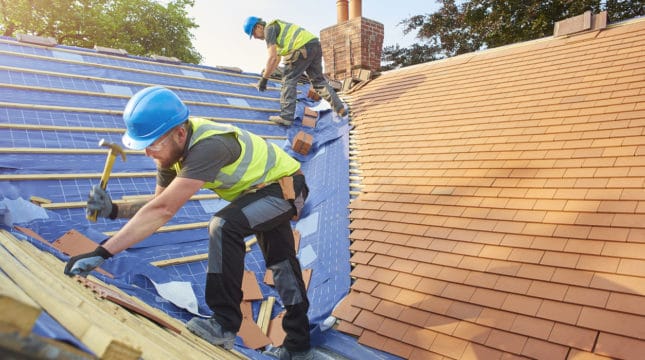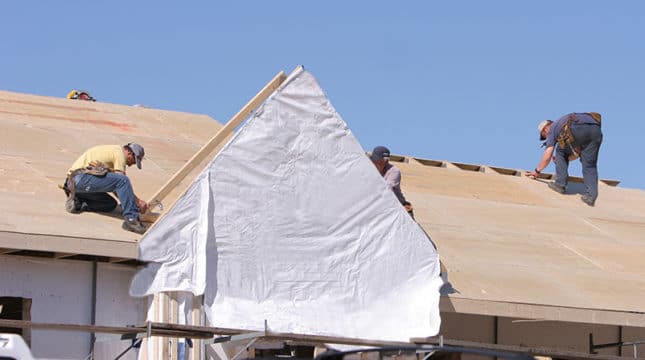Roofers know all too well that water damage is the leading cause of insurance claims in the industry. Most of these claims are caused by unanticipated thunderstorms that bring strong wind and rain, which then damage exposed sections of roof.
Undetected water damage gets worse the longer it goes unnoticed or untreated. Sometimes damage is unavoidable and all roofs wear out after a while. The typical lifespan for a fiber cement shingle roof is 25 years, and that’s if it’s kept in good condition.
Even if you and the homeowners or property owners do everything right, water damage can occur and these claims aren’t cheap. Your roofing business can suffer a loss of money, time and reputation if water damage claims aren’t dealt with quickly and appropriately.
If a storm or leak causes water damage, you might have to use your contractors insurance to help cover repairs if you’re at fault.
Many water damage insurance claims can be prevented
On the bright side, these claims are relatively easy to avoid. As a roofing professional, most water damage insurance claims can be prevented if you follow a few precautionary steps before you start work and while the project is underway.
Here are some tips to help your roofing business avoid losses due to water damage from thunderstorms and other unfortunate events:
Educate all employees and subcontractors
It’s well worth your while to train your employees how to look for causes of water damage — and how to address them.
Prepare a short training manual or hold regular training sessions so that all your employees and subcontractors know what to expect before beginning any work. Damage caused by water is not only costly to your bottom line but also to your reputation. Poor reviews and negative word-of-mouth stories about your business will really hurt your business.
On the flip side, well-informed employees will reassure your clients and help to give you a competitive advantage.
Factor in wind speed
Make sure you and your employees are aware of any weather conditions that may affect your jobsite. This should include daily weather updates as well as monitoring for sudden changes.
Roofs are the most susceptible to damage when winds are stronger than the roof. A strong wind can rip roof coverings from roof decks and roof decks from framing. Roofs can also be destroyed or damaged by debris carried by the wind.
Always cover exposed roofing
Never leave an exposed section of roof before departing a jobsite. Even when no rain is in the forecast, sudden thunderstorms can roll in and cause extensive damage in a short amount of time.
Prepare for sudden changes
While on the jobsite, have a contingency plan for when weather suddenly changes. This includes having readily available tarpaulin materials to protect open sections of roof.
How to properly tarp a roof
- Choose a tarp that’s made of non-reflective sheeting and has a textured surface to reduce slipping.
- When tarping a roof to prevent leakage due to inclimate weather, make sure the tarp is secured to the roof (not just weighted down with sandbags) and that the tarp covers the peak of the roof.
- Always inspect the tarp prior to use. It should have no holes or excessively worn parts that could rip in high winds.
Note: Be careful when walking on a tarp as it can be extremely slippery.
Note when other contractors work on the roof
Roofers are not the only contractors who do work on or near the roof. If another worker has done anything on a jobsite that involves the roof, it's possible that you may not be liable if a claim is brought against you.
For example, if an electrician did some rewiring in an attic and accidentally caused roof tiles that you nailed in to slip, you could argue that this was not your fault and therefore you aren’t liable. You can’t prove this, however, unless you know that the electrician was there so it’s a good idea to take note of other workers who come into contact with the roof at your jobsite.
Respond promptly to water damage emergencies
If water damage does occur, a quick and thorough response to mitigate the cause can drastically reduce the damage and costs of an incident.
For example, if you’re a roofing contractor who agreed to install roof vents in order to fix a leaking roof but the vents instead created more leaks that dripped water into the house, you should return to the home as soon as you can and replace the vents at your own cost.
What happens if you claim water damage on your business insurance
If you and your employees do all you can to prevent water damage from occurring but it happens anyway, you can usually use your roofer insurance to help cover related costs for repairs.
Contact your insurance provider about the situation as soon as possible. Tell them about all the damage and include every detail of the complaint made by a customer.
Some insurance companies will require you to call to report a claim, while others (like Next Insurance) will enable you to file a claim online through an online form or virtual assistant. Learn more about roofing insurance costs here.
When you make a water damage claim, your insurer will investigate the claim to confirm what happened. Once the claim review is complete, your claims advocate will let you know if it is approved or denied.
How Next Insurance protects you from water damage expenses
Part of being prepared is having appropriate insurance, such as general liability insurance, which will help pay for damages made to a residential or commercial property. How much your general liability insurance covers depends on your policy limits.
We specialize in helping construction professionals find the right coverage at an affordable price with our painless online process. Simply answer a few basic questions about your business to get an instant quote, explore coverage options and access your certificate of insurance.
Our licensed, U.S.-based insurance advisors are ready to help you if you have any questions.
Sources:






